2008 FIAT SEDICI tire size
[x] Cancel search: tire sizePage 163 of 266
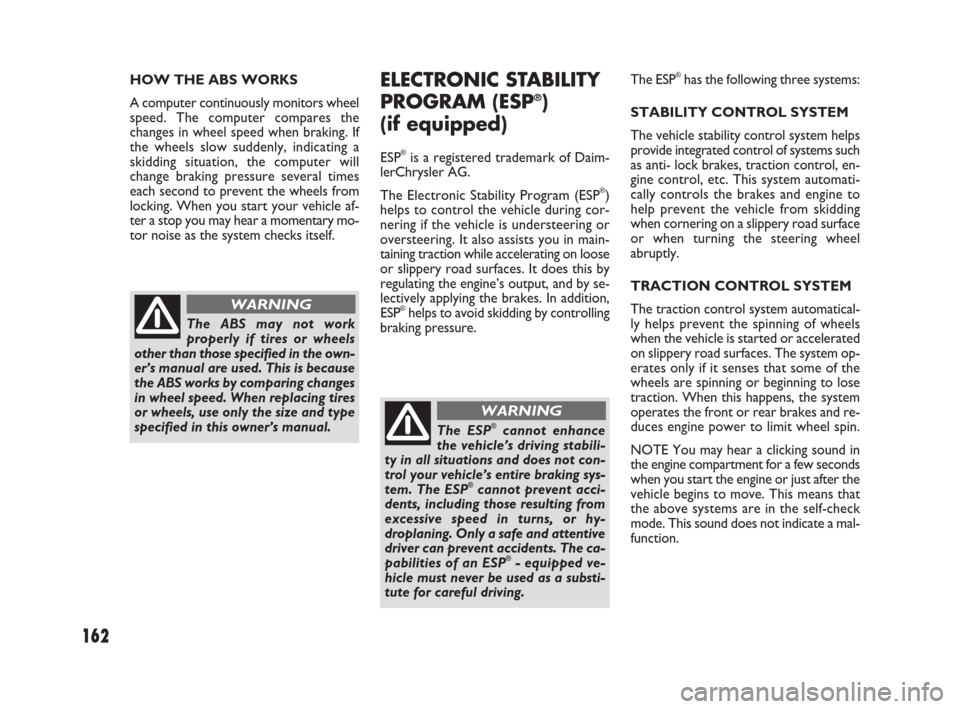
162
HOW THE ABS WORKS
A computer continuously monitors wheel
speed. The computer compares the
changes in wheel speed when braking. If
the wheels slow suddenly, indicating a
skidding situation, the computer will
change braking pressure several times
each second to prevent the wheels from
locking. When you start your vehicle af-
ter a stop you may hear a momentary mo-
tor noise as the system checks itself.
The ABS may not work
properly if tires or wheels
other than those specified in the own-
er’s manual are used. This is because
the ABS works by comparing changes
in wheel speed. When replacing tires
or wheels, use only the size and type
specified in this owner’s manual.
WARNING
ELECTRONIC STABILITY
PROGRAM (ESP®)
(if equipped)
ESP®is a registered trademark of Daim-
lerChrysler AG.
The Electronic Stability Program (ESP
®)
helps to control the vehicle during cor-
nering if the vehicle is understeering or
oversteering. It also assists you in main-
taining traction while accelerating on loose
or slippery road surfaces. It does this by
regulating the engine’s output, and by se-
lectively applying the brakes. In addition,
ESP
®helps to avoid skidding by controlling
braking pressure.
The ESP®cannot enhance
the vehicle’s driving stabili-
ty in all situations and does not con-
trol your vehicle’s entire braking sys-
tem. The ESP
®cannot prevent acci-
dents, including those resulting from
excessive speed in turns, or hy-
droplaning. Only a safe and attentive
driver can prevent accidents. The ca-
pabilities of an ESP
®- equipped ve-
hicle must never be used as a substi-
tute for careful driving.
WARNING
The ESP®has the following three systems:
STABILITY CONTROL SYSTEM
The vehicle stability control system helps
provide integrated control of systems such
as anti- lock brakes, traction control, en-
gine control, etc. This system automati-
cally controls the brakes and engine to
help prevent the vehicle from skidding
when cornering on a slippery road surface
or when turning the steering wheel
abruptly.
TRACTION CONTROL SYSTEM
The traction control system automatical-
ly helps prevent the spinning of wheels
when the vehicle is started or accelerated
on slippery road surfaces. The system op-
erates only if it senses that some of the
wheels are spinning or beginning to lose
traction. When this happens, the system
operates the front or rear brakes and re-
duces engine power to limit wheel spin.
NOTE You may hear a clicking sound in
the engine compartment for a few seconds
when you start the engine or just after the
vehicle begins to move. This means that
the above systems are in the self-check
mode. This sound does not indicate a mal-
function.
149-166 Fiat16 New GB 3-09-2008 8:15 Pagina 162
Page 164 of 266
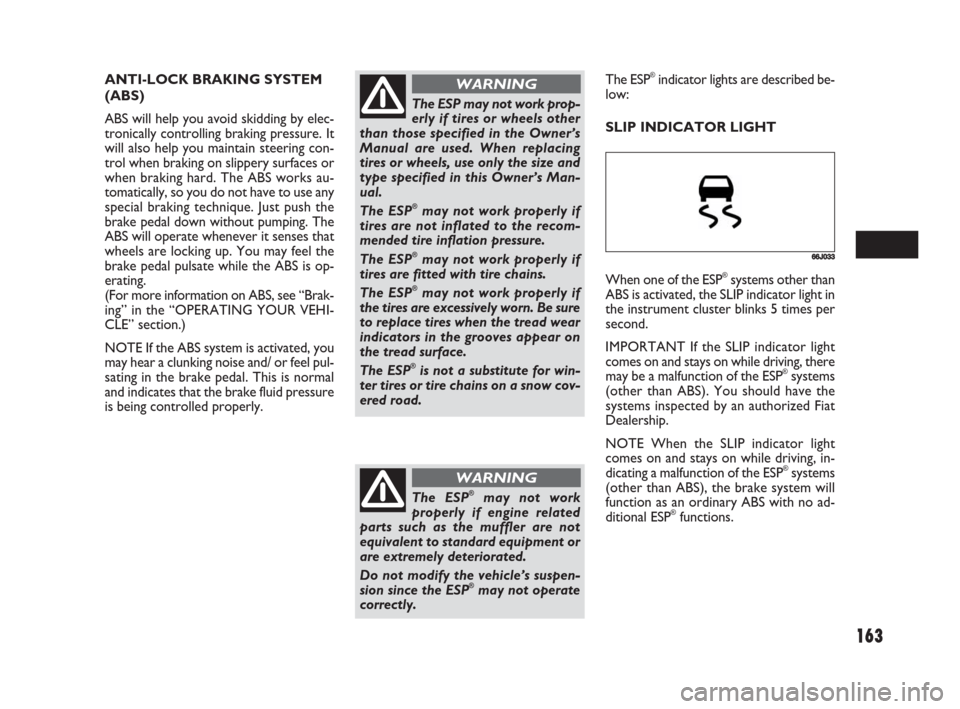
163
The ESP may not work prop-
erly if tires or wheels other
than those specified in the Owner’s
Manual are used. When replacing
tires or wheels, use only the size and
type specified in this Owner’s Man-
ual.
The ESP
®may not work properly if
tires are not inflated to the recom-
mended tire inflation pressure.
The ESP
®may not work properly if
tires are fitted with tire chains.
The ESP
®may not work properly if
the tires are excessively worn. Be sure
to replace tires when the tread wear
indicators in the grooves appear on
the tread surface.
The ESP
®is not a substitute for win-
ter tires or tire chains on a snow cov-
ered road.
WARNING
The ESP®may not work
properly if engine related
parts such as the muffler are not
equivalent to standard equipment or
are extremely deteriorated.
Do not modify the vehicle’s suspen-
sion since the ESP
®may not operate
correctly.
WARNING
ANTI-LOCK BRAKING SYSTEM
(ABS)
ABS will help you avoid skidding by elec-
tronically controlling braking pressure. It
will also help you maintain steering con-
trol when braking on slippery surfaces or
when braking hard. The ABS works au-
tomatically, so you do not have to use any
special braking technique. Just push the
brake pedal down without pumping. The
ABS will operate whenever it senses that
wheels are locking up. You may feel the
brake pedal pulsate while the ABS is op-
erating.
(For more information on ABS, see “Brak-
ing” in the “OPERATING YOUR VEHI-
CLE” section.)
NOTE If the ABS system is activated, you
may hear a clunking noise and/ or feel pul-
sating in the brake pedal. This is normal
and indicates that the brake fluid pressure
is being controlled properly.The ESP®indicator lights are described be-
low:
SLIP INDICATOR LIGHT
66J033
When one of the ESP®systems other than
ABS is activated, the SLIP indicator light in
the instrument cluster blinks 5 times per
second.
IMPORTANT If the SLIP indicator light
comes on and stays on while driving, there
may be a malfunction of the ESP
®systems
(other than ABS). You should have the
systems inspected by an authorized Fiat
Dealership.
NOTE When the SLIP indicator light
comes on and stays on while driving, in-
dicating a malfunction of the ESP
®systems
(other than ABS), the brake system will
function as an ordinary ABS with no ad-
ditional ESP
®functions.
149-166 Fiat16 New GB 3-09-2008 8:15 Pagina 163
Page 170 of 266
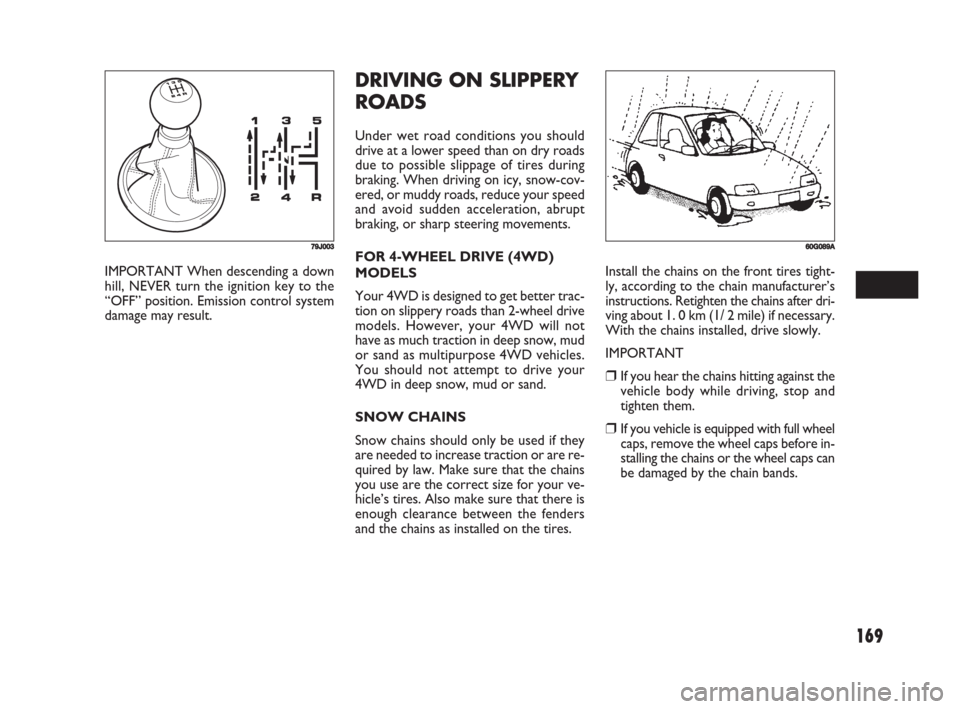
169
DRIVING ON SLIPPERY
ROADS
Under wet road conditions you should
drive at a lower speed than on dry roads
due to possible slippage of tires during
braking. When driving on icy, snow-cov-
ered, or muddy roads, reduce your speed
and avoid sudden acceleration, abrupt
braking, or sharp steering movements.
FOR 4-WHEEL DRIVE (4WD)
MODELS
Your 4WD is designed to get better trac-
tion on slippery roads than 2-wheel drive
models. However, your 4WD will not
have as much traction in deep snow, mud
or sand as multipurpose 4WD vehicles.
You should not attempt to drive your
4WD in deep snow, mud or sand.
SNOW CHAINS
Snow chains should only be used if they
are needed to increase traction or are re-
quired by law. Make sure that the chains
you use are the correct size for your ve-
hicle’s tires. Also make sure that there is
enough clearance between the fenders
and the chains as installed on the tires.Install the chains on the front tires tight-
ly, according to the chain manufacturer’s
instructions. Retighten the chains after dri-
ving about 1. 0 km (1/ 2 mile) if necessary.
With the chains installed, drive slowly.
IMPORTANT
❒If you hear the chains hitting against the
vehicle body while driving, stop and
tighten them.
❒If you vehicle is equipped with full wheel
caps, remove the wheel caps before in-
stalling the chains or the wheel caps can
be damaged by the chain bands. IMPORTANT When descending a down
hill, NEVER turn the ignition key to the
“OFF” position. Emission control system
damage may result.
79J00360G089A
167-170 Fiat16 New GB 3-09-2008 8:15 Pagina 169
Page 171 of 266
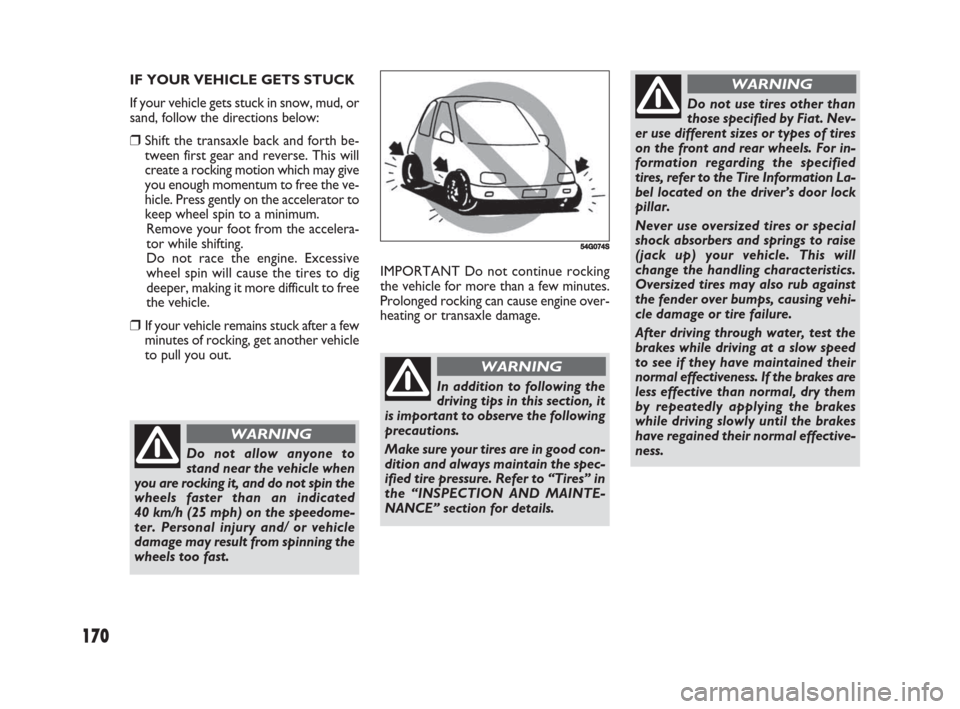
170
IMPORTANT Do not continue rocking
the vehicle for more than a few minutes.
Prolonged rocking can cause engine over-
heating or transaxle damage. IF YOUR VEHICLE GETS STUCK
If your vehicle gets stuck in snow, mud, or
sand, follow the directions below:
❒Shift the transaxle back and forth be-
tween first gear and reverse. This will
create a rocking motion which may give
you enough momentum to free the ve-
hicle. Press gently on the accelerator to
keep wheel spin to a minimum.
Remove your foot from the accelera-
tor while shifting.
Do not race the engine. Excessive
wheel spin will cause the tires to dig
deeper, making it more difficult to free
the vehicle.
❒If your vehicle remains stuck after a few
minutes of rocking, get another vehicle
to pull you out.
Do not allow anyone to
stand near the vehicle when
you are rocking it, and do not spin the
wheels faster than an indicated
40 km/h (25 mph) on the speedome-
ter. Personal injury and/ or vehicle
damage may result from spinning the
wheels too fast.
WARNING
54G074S
In addition to following the
driving tips in this section, it
is important to observe the following
precautions.
Make sure your tires are in good con-
dition and always maintain the spec-
ified tire pressure. Refer to “Tires” in
the “INSPECTION AND MAINTE-
NANCE” section for details.
WARNING
Do not use tires other than
those specified by Fiat. Nev-
er use different sizes or types of tires
on the front and rear wheels. For in-
formation regarding the specified
tires, refer to the Tire Information La-
bel located on the driver’s door lock
pillar.
Never use oversized tires or special
shock absorbers and springs to raise
(jack up) your vehicle. This will
change the handling characteristics.
Oversized tires may also rub against
the fender over bumps, causing vehi-
cle damage or tire failure.
After driving through water, test the
brakes while driving at a slow speed
to see if they have maintained their
normal effectiveness. If the brakes are
less effective than normal, dry them
by repeatedly applying the brakes
while driving slowly until the brakes
have regained their normal effective-
ness.
WARNING
167-170 Fiat16 New GB 3-09-2008 8:15 Pagina 170
Page 208 of 266
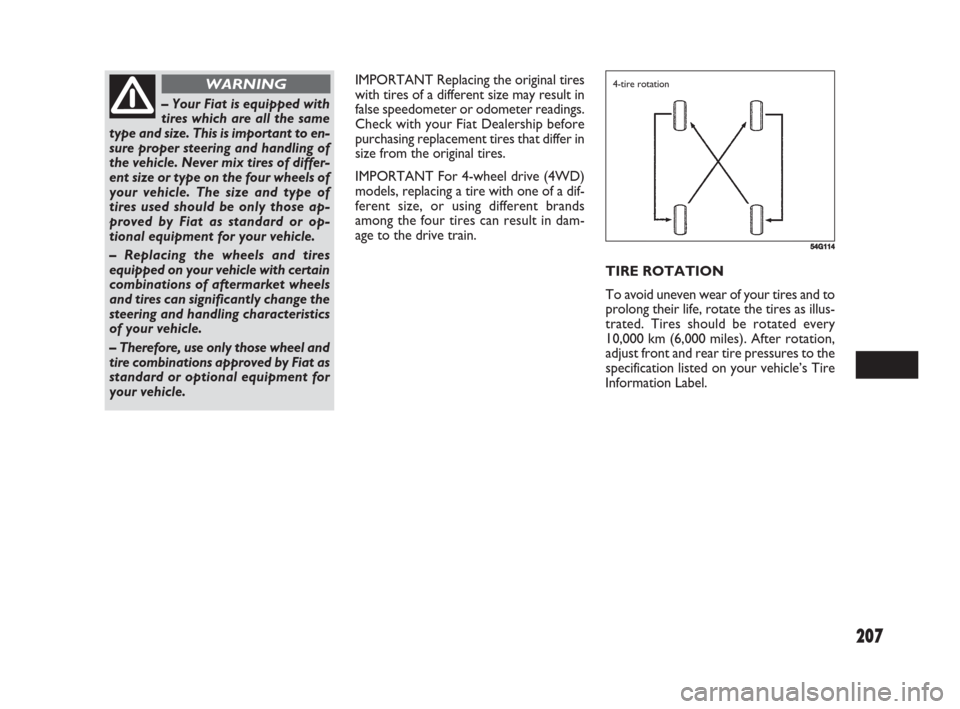
207
IMPORTANT Replacing the original tires
with tires of a different size may result in
false speedometer or odometer readings.
Check with your Fiat Dealership before
purchasing replacement tires that differ in
size from the original tires.
IMPORTANT For 4-wheel drive (4WD)
models, replacing a tire with one of a dif-
ferent size, or using different brands
among the four tires can result in dam-
age to the drive train.
TIRE ROTATION
To avoid uneven wear of your tires and to
prolong their life, rotate the tires as illus-
trated. Tires should be rotated every
10,000 km (6,000 miles). After rotation,
adjust front and rear tire pressures to the
specification listed on your vehicle’s Tire
Information Label.
– Your Fiat is equipped with
tires which are all the same
type and size. This is important to en-
sure proper steering and handling of
the vehicle. Never mix tires of differ-
ent size or type on the four wheels of
your vehicle. The size and type of
tires used should be only those ap-
proved by Fiat as standard or op-
tional equipment for your vehicle.
– Replacing the wheels and tires
equipped on your vehicle with certain
combinations of aftermarket wheels
and tires can significantly change the
steering and handling characteristics
of your vehicle.
– Therefore, use only those wheel and
tire combinations approved by Fiat as
standard or optional equipment for
your vehicle.
WARNING
54G114
4-tire rotation
181-224 Fiat16 New GB 3-09-2008 8:18 Pagina 207
Page 209 of 266
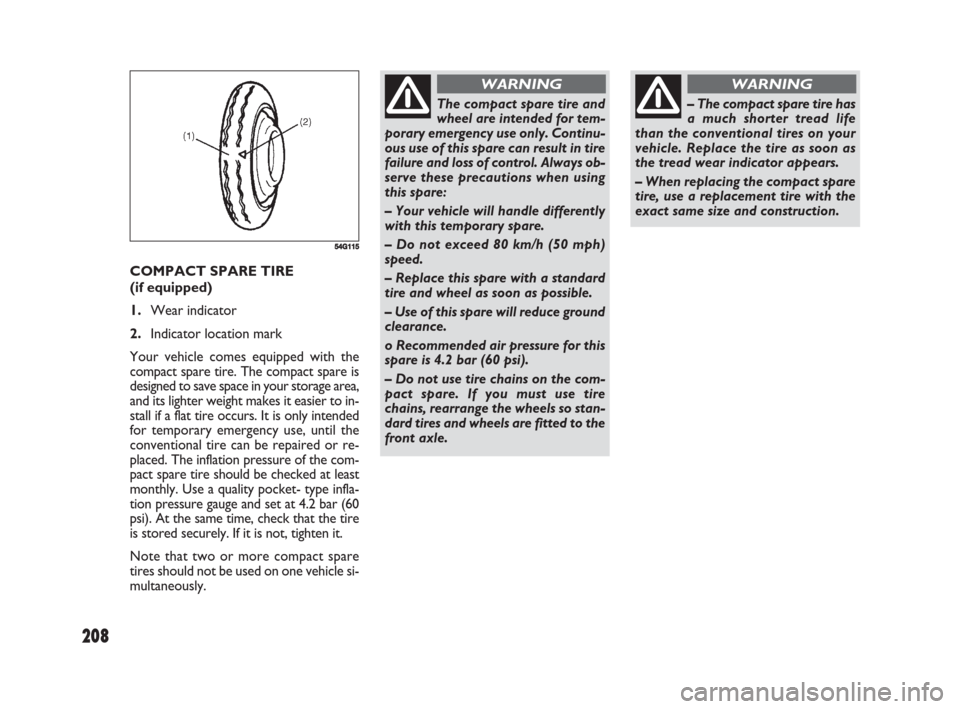
208
COMPACT SPARE TIRE
(if equipped)
1.Wear indicator
2.Indicator location mark
Your vehicle comes equipped with the
compact spare tire. The compact spare is
designed to save space in your storage area,
and its lighter weight makes it easier to in-
stall if a flat tire occurs. It is only intended
for temporary emergency use, until the
conventional tire can be repaired or re-
placed. The inflation pressure of the com-
pact spare tire should be checked at least
monthly. Use a quality pocket- type infla-
tion pressure gauge and set at 4.2 bar (60
psi). At the same time, check that the tire
is stored securely. If it is not, tighten it.
Note that two or more compact spare
tires should not be used on one vehicle si-
multaneously.
54G115
The compact spare tire and
wheel are intended for tem-
porary emergency use only. Continu-
ous use of this spare can result in tire
failure and loss of control. Always ob-
serve these precautions when using
this spare:
– Your vehicle will handle differently
with this temporary spare.
– Do not exceed 80 km/h (50 mph)
speed.
– Replace this spare with a standard
tire and wheel as soon as possible.
– Use of this spare will reduce ground
clearance.
o Recommended air pressure for this
spare is 4.2 bar (60 psi).
– Do not use tire chains on the com-
pact spare. If you must use tire
chains, rearrange the wheels so stan-
dard tires and wheels are fitted to the
front axle.
WARNING
– The compact spare tire has
a much shorter tread life
than the conventional tires on your
vehicle. Replace the tire as soon as
the tread wear indicator appears.
– When replacing the compact spare
tire, use a replacement tire with the
exact same size and construction.
WARNING
181-224 Fiat16 New GB 3-09-2008 8:18 Pagina 208